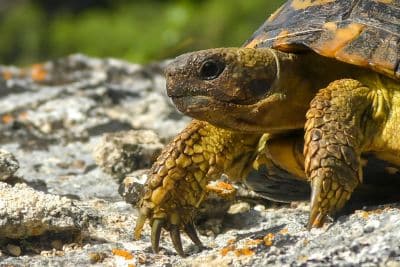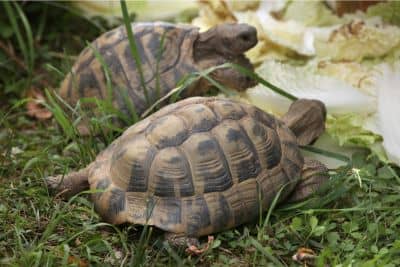Thought to have inspired Aesop’s famous fable, ‘The Hare and the Tortoise’, the Greek tortoise (Testudo graeca) stands out for its rich history and distinct physical characteristics.
Also known as the Mediterranean Thigh-Spurred Tortoise, this reptile species encompasses several subspecies, including the Moroccan, Mesopotamian (or Golden Greek), Iberian (or Asia Minor), and Libyan Greek tortoise.
The Greek tortoise got its name from its distinct mosaic-like carapace (shell) patterns, which can vary significantly across subspecies. They exhibit a range of colors from olive to yellow with black or brown markings. It’s easy to identify Greek tortoises that originate from cooler climates due to their darker-colored shells that allow them to absorb and retain more light.
Another significant characteristic of the Greek tortoise is the conical-shaped horns (known as spurs) on their thighs – which is why this tortoise is also known as the Mediterranean Thigh-Spurred Tortoise.
In addition, their rear plastron (the shell under their belly) is slightly movable, and although they are often mistaken for Hermann’s tortoise, both these distinguishing features are used to tell them apart.
Habitat
Originating from the arid and semi-arid regions of North Africa, Southern Europe, and parts of Asia, these tortoises have adapted to a variety of habitats.
From dry, arid desert scrublands and coastal regions to grasslands and forest margins, they have evolved to thrive in a climate that alternates between hot, dry summers and mild winters.
Greek tortoises make great pets and are perfect for beginner tortoise enthusiasts thanks to their compact size and adaptability. Even so, owning one or more requires dedication and should be seen as a lifelong commitment.
In addition to acquiring these animals from reputable sources that prioritize their well-being and conservation, it is also worth consulting with the International Union for Conservation of Nature (IUCN). They can provide details of any subspecies listed under a conservation status relating to poaching or illegal pet trades.
Size
Adult Greek Tortoises can weigh up to 2kg, with an average shell length of 8 inches. Females are generally slightly smaller than males. Both males and females can take up to 10 years to reach their full size and have a potential lifespan of over 50 years when properly cared for.
Greek tortoises make great pets due to their relatively small size and they have four distinct stages of growth. The table below includes the age range for each stage, along with corresponding average weights and lengths.
| Growth Stage | Age Range | Average Weight | Average Length |
| Hatchling | 0-1 year | 10-30 grams | 3-5 cm (1.2-2 in) |
| Juvenile | 1-5 years | 30-200 grams | 5-10 cm (2-4 in) |
| Subadult | 5-10 years | 200-500 grams | 10-15 cm (4-6 in) |
| Adult | 10+ years | 500 grams – 2 kg | 15-25 cm (6-10 in) |
These values should be used as a guideline because factors such as genetics, diet, and environmental conditions all play a part in a tortoise’s growth.
If you have any concerns about the development of your tortoise, you should consult with a reptile veterinarian.
Enclosures
Creating a suitable environment that replicates their natural conditions as closely as possible is important throughout each stage of their lives and will help to reduce the potential for stress, illness, and disease. This includes managing temperature gradients and providing adequate UVB lighting to ensure healthy shell and bone development.
Greek tortoises require considerably less room than some larger breeds, such as Sulcatas, making them a suitable choice for those with limited space.
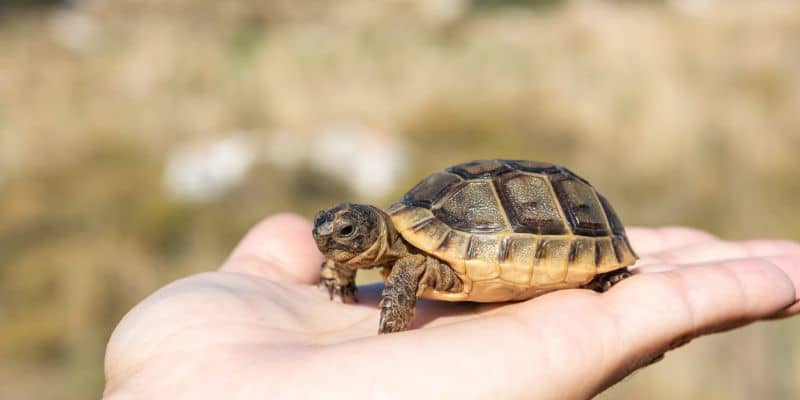
Although hatchlings are small, to begin with, they grow fast! I recommend starting out with an enclosure of around 3ft x 2ft, with 12” sides. You can always section it off to begin with.
The housing will need a well-fitting lid and good ventilation.
For juveniles, an enclosure measuring 4ft x 2ft is sufficient, and subadults and adults need at least 6ft x 3ft, with sides at least 12” high.
It’s essential that you decorate the enclosure with a variety of plants, hollowed-out logs and rocks. This will ensure they have ample space to roam, explore, and engage in natural behaviors such as basking, burrowing, sleeping, keeping cool and eating.
Given their smaller size, indoor-bred Greek Tortoises can live comfortably on tortoise tables. However, if you have two or more, you’ll need to provide ample space to reduce the potential for aggressive behavior and competition over territory and resources.
Just like all other tortoise breeds, Greek tortoises require a basking area with plenty of south-facing sunlight or appropriate UVB lighting to simulate sunlight. They also need shaded areas and hiding spots to provide relief from heat and create a sense of security.
Outdoor enclosures will require a shelter to protect against extreme weather conditions and will need to be secured with a mesh cover to prevent escape and protect against predators.
Temperature and Light
As diurnal reptiles, Greek Tortoises are very much reliant on UV light, which is available either from sunlight or UV artificial lights.
In their natural habitat, these cold-blooded creatures use the heat of the sun to regulate their body temperature (thermoregulation). They also use UVB rays to synthesize vitamin D which allows them to absorb the calcium required to maintain bone and shell health.
Since these reptiles are very much reliant on temperature and light, the question for all new Greek tortoise owners is: can your climate provide the right amount of sunlight, or will you need to use artificial lighting and heating?
Answering this question will determine whether you locate your tortoise indoors or outside. Here’s a breakdown of what you should consider:
For your Greek tortoise to thrive, you’ll need to be able to replicate the warm, sunny days and cooler nights of the Mediterranean, where daytime temperatures can reach 100°F, dropping to 85°F at night.
Their enclosure needs to provide an area to warm their body up, plus more ambient and cooler spots to cool down.
Basking Area
During the day, they need a basking area that can reach temperatures between 95°F and 100°F (35°C to 38°C). This warm spot enables the tortoise to thermoregulate and is essential for their metabolism, the absorption of calcium, and digestion.
For indoor enclosures, you will need a basking light that can be fitted with a dimmer switch. 160 to 250W is suitable for juveniles and adults, and 75 to 100W is sufficient for hatchlings.
I recommend Zoo Med T5 10.0 fluorescent tubes and Arcadia 12% T5 fluorescent tubes. Both should be mounted at a height of 8-12” from the top of the tortoise’s shell.
Ultimately, the temperature in your home will determine bulb wattage and mounting distance, so be sure to install a digital thermometer in the basking area to monitor heat and adjust accordingly if temperatures reach more than 100°F.
Ambient Area
In addition to a basking zone, the enclosure will also need an area with an ambient temperature in the region of 75°F to 85°F (24°C to 29°C).
For outside enclosures, this can be achieved by providing hollow logs, vegetation or a shelter that can shade your tortoise from the intense heat of the day.
If the enclosure is indoors and the heat from the basking light is not enough or you need to provide additional heat (i.e. for bigger enclosures or at night), choose a ceramic heat emitter such as the Omayey 2-Pack 100W Ceramic Heat Lamp.
Are You Starving Your Tortoise?
Save 10% on premium tortoise food and supplements from Tortoise Resource Center on Amazon now using code BUYNOWGET10
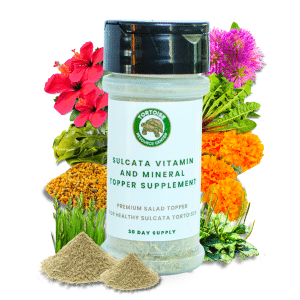
Sulcata Vitamin & Mineral Topper Supplement
30-Day Supply | 2 oz (56 g)
$24.99
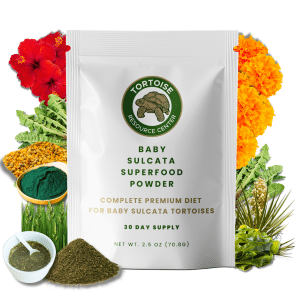
Baby Sulcata Tortoise Superfood Powder
30-Day Supply | 2.5 oz (70.8 g) Bag
$24.99
Nighttime
Greek tortoises are well-adapted to cooler nighttime temperatures of between 60°F to 70°F (15°C to 21°C), although this should be higher for juveniles, stressed or ailing tortoises.
Winter
In regions with mild winters where average temperatures drop no lower than 85°F, Greek Tortoises can often live happily outdoors year-round, provided they have access to a well-insulated and heated shelter that allows them to escape a sudden temperature drop. This should be heated to around 75°F to 85°F to mimic the ambient daytime temperatures of the Mediterranean.
Bring your tortoise indoors if you live in a region with cold winters. This will help to prevent cold stress or hibernation complications.
Humidity
The arid and semi-arid environments in which these tortoises have originated means they have adapted to relatively low humidity levels. They can tolerate levels of around 30% to 50% during the day. At night, when their natural habitat has a slight drop in temperature, humidity should be increased to around 60%.
This range is sufficient to keep Greek Tortoises comfortable without the risk of dehydration and overly dry conditions and for preventing health issues such as digestion issues, eye problems and respiratory infections.
Conversely, too much moisture can also cause health issues such as respiratory infections, shell rot or pyramiding, and skin infections.
I recommend investing in a digital hydrometer to monitor the humidity levels within the enclosure. You may need to adjust humidity levels with each season.
You should also ensure that the enclosure has good ventilation, especially if it is located indoors. This will help to prevent the buildup of excessive humidity.
If you need to increase humidity, you could lightly mist the substrate, especially in drier climates or heated indoor environments. Avoid over-misting, as this will cause a soggy substrate and lead to the health issues listed above.
Avoid placing water dishes in the basking area, as this can cause excessive evaporation and humidity spikes.
Choosing the right substrate can also help in managing humidity levels. Materials like coconut coir or sphagnum moss are well-draining and, when mixed with sand, will retain moisture without becoming overly wet.
Substrate
The base of the enclosure will need to be covered with a well-draining substrate at a depth of 10 to 12”.
Use a mix of play sand, dry sphagnum moss, coco coir and soil (such as Zoo Med Reptisoil) that allows for digging and burrowing, and to mimic their natural habitat.
In addition, add dry hay, such as Timothy hay, to the cooler zone. This will allow your tortoise to feel secure and help to reduce the potential for stress.
Keeping the Enclosure Clean
Tortoises defecate in their water a lot, so sanitizing the dish and replenishing it with fresh water daily is essential in reducing the risk of digestion problems caused by bacteria.
I also advise daily spot cleaning of the substrate as this quickly becomes littered with feces and uneaten food. Again, any accumulation of waste will encourage bacteria that can incite health issues.
At least every three months, I recommend a deep cleaning of your tortoise’s enclosure. This involves removing all substrate, waste, and uneaten food. You’ll then need to sanitize the floor and walls before replenishing with fresh substrate.
When deep cleaning, it’s a good idea to clean any equipment (thermometers, heat lamps, UVB lights and fixtures etc), using a reptile-safe disinfectant such as Fluker’s Super Scrub Cleaner.
Be sure to wash your hands after handling your tortoise and cleaning enclosures and equipment. Tortoises can appear healthy and well but may harbor infections and diseases long before displaying physical symptoms.
Diet, Supplements, and Water Requirements
Greek Tortoises are strictly herbivores, and their captive diet should closely mimic what they would eat in their natural Mediterranean environments. This means you will need to provide a variety of grasses, herbs, leaves, and even some flowers.
Diet
These reptiles thrive on a high-fiber, low-protein, and calcium-rich diet. Their primary food should consist of:
Grasses and Hay: These provide essential fiber and should make up the bulk of their diet. Hay should be fresh and free from mold, and both must be free from pesticides and, ideally, organic.
Timothy grass, orchard grass, Bermuda grass, orchard hay and meadow hay are all high in fiber and low in protein and fat. Offer as much variety as possible to ensure a balance of nutrients and encourage healthy digestion. Plus, a diverse range of tastes and textures will help maintain their interest in food.
Leafy Greens: Offer a variety of leafy greens, such as dandelion greens, kale, collard greens, and mustard greens.
As well as helping to keep your tortoise hydrated, leafy greens provide essential nutrients, including vitamins A, K, C and E and are also rich in calcium and minerals.
A varied diet will support bone and shell growth, immune function, cell development and eye health.
Edible Flowers: Hibiscus, nasturtium, and dandelion flowers contain tortoise-friendly vitamins, including vitamins K, C and A, as well as being low in fat and protein and high in fiber.
When offered as an occasional treat, flowers can stimulate their natural foraging behavior, making their daily activities more interesting and engaging.
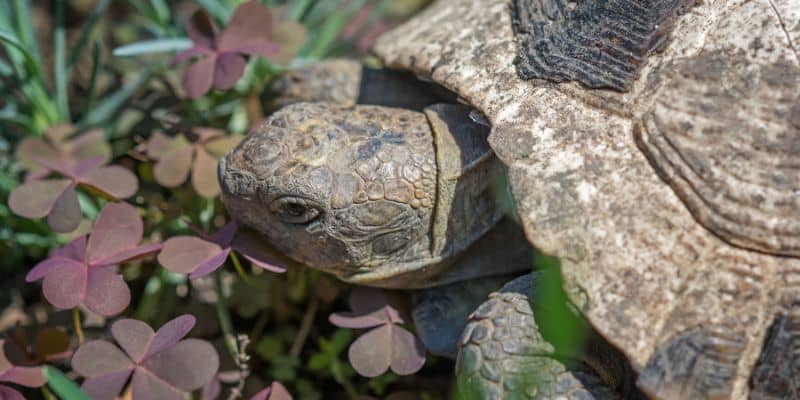
Weeds and Herbs: Weeds like clover and plantain are excellent natural food sources, along with culinary herbs such as parsley and basil. Again, offer these in moderation as an occasional treat.
Avoid feeding Greek Tortoises with fruit. The high sugar content can potentially lead to digestive health issues.
Feeding Practices
Provide food in moderation to avoid the common problem of obesity in captive tortoises.
Hatchlings and juvenile tortoises should be fed daily due to their rapid growth, while adults can be fed every other day to avoid overfeeding.
Keep a close eye on your tortoise’s eating habits, weight, and body condition and adjust their diet if any significant health, activity, and weight changes occur.
Supplements
A varied diet should ensure that your Greek tortoise receives the right amount of calcium and vitamins. However, periods of stress or illness, often caused by poor husbandry or diet, can reduce appetite or lead to a vitamin deficiency. In this case, your veterinarian may recommend supplements.
A reptile-appropriate multivitamin supplement sprinkled on food can help to cover any nutritional gaps, particularly vitamins D3, A, and K.
Similarly, calcium dust sprinkled on food and provided every other day can help to ensure proper shell and bone development. Alternatively, place a cuttlefish bone in the enclosure for your tortoise to graze on. This will not only benefit their calcium intake but will also help to keep their beak trim.
Be cautious with the quantity of supplemental vitamin D3; however, especially if your tortoise is regularly exposed to adequate UV light, over-supplementation can lead to toxicity.
Water Requirements
Despite their arid native habitats, Greek Tortoises must always have access to fresh drinking water to aid hydration and encourage good digestion.
Tortoises can be prone to drowning, so make sure that water bowls are shallow and that water is no deeper than elbow height.
Make sure that it is easy for your tortoise to access and is kept away from intense heat (to avoid evaporation). Top up with clean, fresh water daily to reduce the risk of bacteria growth.
Care
A thriving captive tortoise requires much more than just feeding and providing an adequate space in which to live.
In this section, I’ll be explaining more essential aspects of their care, including hibernation, handling and temperament, bathing, enrichment activities, and breeding and caring for hatchlings.
Hibernation
If your Greek tortoise’s environment mirrors their natural cycle in the wild, they are likely to hibernate.
In their natural habitat, they typically begin their hibernation process in late autumn as temperatures start to drop, usually around October or November. This period of dormancy can last until early spring, around March or April, depending on local climatic conditions.
You can influence the likelihood of your tortoise hibernating by slightly decreasing the temperature and their exposure to daylight accordingly.
It’s worth noting that only healthy tortoises should be considered for hibernation. Young, ill, or underweight tortoises may not have the reserves to safely undergo hibernation, and you should always check with your veterinarian before making any changes to their environment.
If they pass a veterinary-approved check and are deemed healthy and of adequate weight, you can begin preparations for their hibernation.
From August onward you will need to slowly lower the temperature down to between 39°F- 50°F over several weeks. This will simulate the approach of winter and encourage natural hibernation behavior.
You then need to create a safe, controlled hibernation space where temperature can be maintained between 39°F to 50°F and humidity levels at around 30 to 50%. These need to be consistently monitored throughout their hibernation period.
Stop feeding your tortoise 2-3 weeks before the anticipated start of hibernation. This will allow it to empty its stomach and intestines and reduce the risk of rotting food causing infections.
Even during hibernation, it’s important to periodically check on your tortoise. Make sure that the hibernation environment remains at a stable, cool temperature and that your tortoise remains in good condition throughout the hibernation period.
When it emerges from hibernation, offer warm baths to hydrate the tortoise and reintroduce food gradually.
Handling and Temperament
Greek Tortoises are generally docile, but they are not keen on being handled, so limit how often you pick them up to reduce stress.
When you do need to move them around, always support the tortoise’s body fully, keeping it level to minimize anxiety and keep an eye on their behavior. Withdrawal into the shell or hissing can indicate stress. This is a clear sign that it’s time to put the tortoise back into its enclosure.
Cohabitation can lead to aggression, particularly among males. This is often related to territorial disputes, competition for food, or mating attempts.
To minimize fighting, I recommend housing tortoises separately, especially if they have shown signs of aggression, such as ramming into each other, biting, and chasing. Such behaviors can lead to stress, physical injuries, and even serious harm if not properly managed.
While female tortoises can coexist more peacefully, issues can still arise, especially in enclosures that are too small or lack sufficient resources for all individuals.
If you do have more than one tortoise in the same enclosure, you’ll need to keep a watchful eye on them and make sure you provide ample space to reduce competition over territory and resources.
Bathing
Regular soaking helps with hydration, promotes healthy skin and shell development, and will help to keep your tortoise clean.
Bathe adult Greek tortoises in lukewarm water once a week, allowing them to soak for 15-30 minutes. Sick adults can be bathed 2-3 times per week, which may help to aid their recovery.
Hatchlings need to be bathed every 2-3 days for a couple of reasons. Firstly, they often get feces stuck to their vent area, and this requires regular cleaning.
Secondly, hatchlings can have difficulty staying hydrated or shedding properly, so bathing them can help.
Regardless of age, water temperature should be in the region of bath of 80°F to 85°F, and they should remain in the water for 30 minutes or less. To avoid drowning, water depth should be restricted to elbow height, and you should never leave your tortoise unattended during bath time.
Enrichment Activities
In their natural habitat, Greek tortoises spend much of their time foraging for food and burrowing into the ground to help them regulate their body temperature during the heat of the day.
In captivity, there is a tendency for pet tortoises to become overweight because food is in abundance, and they don’t need to move very far to find it.
Tortoises need space to roam, and they need enrichment activities such as hollowed-out logs, rocks, and plants to ensure they get regular exercise and can explore. It’s also a good idea to provide foraging opportunities like hiding food within their enclosure.
If your tortoise lives indoors, it’s a good idea to provide the occasional supervised time outdoors in a secured area.
Citations
- Garden State Tortoise – Greek Tortoise Care Guide
- Reptifiles – Tortoise Husbandry
- BCG – Care for Greek Tortoise Hatchlings

